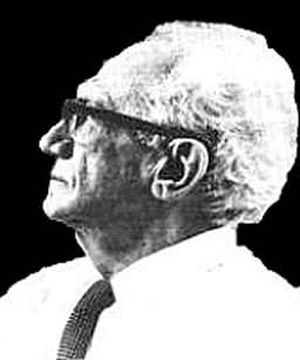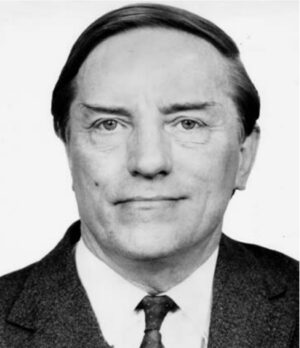Derek Victor Ager (1923-1993 ) was a British palaeontologist, former President of the British Geological Association, and Emeritus Professor of Geology, University College of Swansea, Wales, and critic of Immanuel Velikovsky.
On Velikovsky
Writing in Catastrophist Geology, Ager writes:
“Since (your proposed journal) seems to be so much in line with my own ideas – as expressed in my book “The Nature of the Stratigraphical Record”, Macmillan’s 1973 – I am naturally very interested in the project. Whilst remaining, I hope, broad-minded I must express strong doubts about the desirability of including discussions of some aspects of the “Lunatic fringe”. Thus my book brought me much literature from the Velikovsky band, but when I asked for concrete geological evidence there was immediate and complete silence. “Neocatastrophism” is in my view, a valid scientific hypothesis that deserves more careful attention by geologists, but we will not acquire scientific respectability if we associate ourselves with Atlantis-hunters or for that matter, flat-earthers!”[1]Derek V.Ager, “Comments”, Catastrophist Geology, Year 1 No. 1 (June 1976)
In his book, The New Catastrophism, Ager writes:
“The height of such idiocy is illustrated by the cult of Velikovsky, who postulated major collisions up into historic times. I was repeatedly urged to read his works by one of his adherents. Whilst giving a course of lectures in Amsterdam and Leiden and left in the evenings with nothing to read, I chanced upon a copy of one of his works in a back-street bookshop. I will not encourage such pseudo-science by giving a reference. I will be presumptious enough, however, to quote my own subsequent letter to my correspondent about the book I had read:
“I was frankly appalled. It was far worse than I had been led to suppose. I can assure you that 90% of it is the most unmitigated nonsense. He does not present any geological data whatever to support his views. He merely cites very out-of-date authorities (some 18th century!) in a highly selective manner. It is rather like someone quoting mediaeval alchemists to disprove modern atomic theory. He puts together observations which have no possible connection with each other. He appears to have no concept whatever of the geological time-scale and associates things which happened tens of millions or even hundreds of millions of years apart. He seems oblivious of the hundreds of thousands of successive fossiliferous horizons there are in the rocks of almost every part of the earth’s surface and even seems to he unaware of the normal mortality of living organisms. The idiocy of some of his dogmatic pronouncements is illustrated, for example, in the alleged transport of vast numbers of large vertebrates from the tropics to the arctic by a great wave that did nor apparently carry with it a single marine organism.”
“I am sorry if I appear to be neurotic about this, especially as Velikovsky seems to be on the side of the catastrophists, but I do not want to ha associated in any way with such nonsense. This, together with the writings of the Californian ‘creationists’ am the reason for my disclaimer at the beginning of this book.”[2]Derek Ager, The new catastrophism: the importance of the rare event in geological history. Published by Cambridge University Press, 1995, ISBN 0521483581, 231 pages (page 179-180)[3]Catastrophist Geology I:1 (1976), p. 4; II:1 (1977), p. 14.
Velikovsky biographer Duane Vorhees writes:
“With the demise of Pensée coinciding with the birth of its successors, many Velikovskians sought to infiltrate other organizations. A few, including anthropologist Roger W. Wescott, physicist H. C. Dudley, and Dutch chemist G.W. van Oosterhout managed to place themselves on the advisory board of Johan Kloosterman‘s short-lived journal devoted to Catastrophist Geology, where they were joined by other luminaries such as astronomer V. Axel Firsoff and mathematician Rene Thom. Other establishment non-uniformitarians such as Derek V. Ager professed ideological support for “neocatastrophism” (as he called his particular hypothesis to distinguish it from “the ideas of the Noachian deluge people”), but expressed “strong doubts about the desirability of including discussions of some aspects of the ‘lunatic fringe'” and a hesitancy to publish in a journal that included such discussions. Ager noted that his groundbreaking book The Nature of the Stratigraphical Record (1973) had brought him “much literature from the Velikovsky band, but when I asked for concrete geological evidence there was immediate and concrete silence.” In a later disagreement over geological interpretation, Kloosterman suggested that Ager “be classified as a crypto-uniformitarian and not as a neo-catastrophist.”[4]Duane Vorhees, Immanuel Velikovsky’s Jewish Science, unpublished.
Comparison with Velikovsky
C.J. Ransom argues that:
“As does Velikovsky, Ager takes the approach of the inter-disciplinarian. .. Ager’s view is similar to that expressed by Velikovsky in Earth in Upheaval wherein he describes many not easily explained geologic formations and discusses what he terms “cataclysmic evolution”.[5]C.J. Ransom, “Chapter VII: The Earth”, The Age of Velikovsky 1976, Dell Publishing Co., Inc., ISBN 0-440-50323-X
References
| ↑1 | Derek V.Ager, “Comments”, Catastrophist Geology, Year 1 No. 1 (June 1976) |
|---|---|
| ↑2 | Derek Ager, The new catastrophism: the importance of the rare event in geological history. Published by Cambridge University Press, 1995, ISBN 0521483581, 231 pages (page 179-180) |
| ↑3 | Catastrophist Geology I:1 (1976), p. 4; II:1 (1977), p. 14. |
| ↑4 | Duane Vorhees, Immanuel Velikovsky’s Jewish Science, unpublished. |
| ↑5 | C.J. Ransom, “Chapter VII: The Earth”, The Age of Velikovsky 1976, Dell Publishing Co., Inc., ISBN 0-440-50323-X |

